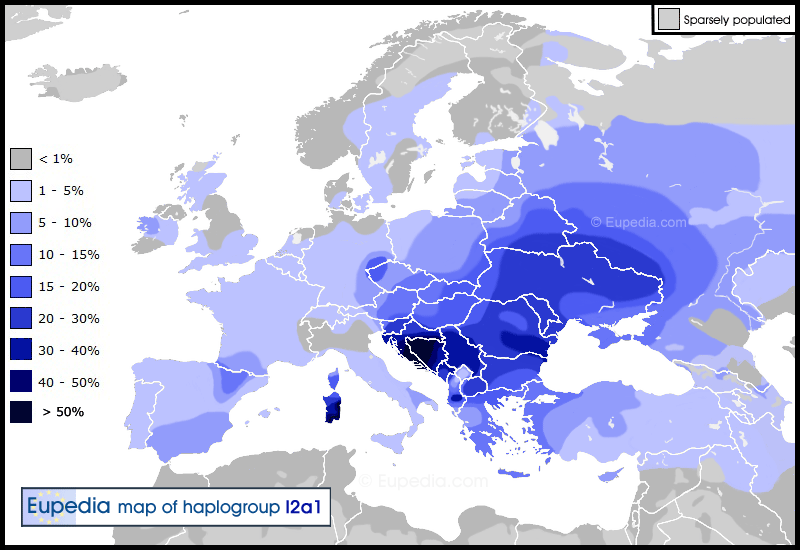Howyesno,
This has to be discussed on another thread really, but I will answer your points. I do not consider that I have 'grossly misinterpreted' anything. From Underhill [2009] it seems clear that R1a1 was already in Germany during the Corded Ware period- some 4,500 years ago. The Slavs did not 'give' this to Germany, as they did not enter Central Europe until 1,500 years ago.
Secondly, as Underhill [ibid] shows, Slavic R1a1 mainly falls into the M458 subclade, which is virtually absent in Germany and Scandinavia.
We really must not hijack this thread re R1a1- it is about I haplogroup.
we are not highjacking thread, as those are related issues.... since I am pretty sure that in early Slavs haplogroup I was dominant haplogroup...
R1a that is in Germany already for 4500 years is the same as the one that is dominant in Poland and Russia... look at data in appendix of that work....or read carefully my reply on that thread...
and btw. R1a probably has nothing to do with early Slavs...
spread of early Slavs has clear signature of I2a2...
R1a are probably assimilated Scythian, Sarmatian and other native people of those areas...who were probably speaking similar language with early Slavs...
very Slavic Serbs and Macedonians have up to 15% R1a...and according to Klyosov that R1a is on Balkan for thousand years before their arrival....
according to
http://onlinelibrary.wiley.com/doi/10.1002/ajpa.21235/suppinfo
(testing done for 179 individuals from Serbia)
Serbia has 48% of haplogroup I which is in fact more than Germany...
haplogroup____Serbia____Montenegro
I1_____________7.8%_____6.2%
I2b1___________1.67%___1.73%
I2a2 __________
38.5% ___29.2%
E1b1b _________ 17.3%___27.0%
R1a____________
14.5%____
7.4%
R1b____________ 4.5%____9.4%
J1______________0.6% ___0.5%
J2a ____________3.3%____4.7%
J2b ____________1.7% ___4.5%
G2a____________2.2%____2.5%
N ______________3.3% ___1.5%
Q _____________1.7%____2.0%
H______________2.2% ___1.5%
L_______________0.6%____1.2%
now, ethnic Albanians from Macedonia who never mixed with Slavic people have approximatelly the same R1a percentage as Slavic Serbs and Macedonians .... and Slavic people of Montenegro (who considered themselves Serbs till recently) have only around half of that value ..
http://www.bjmg.edu.mk/UploadedImages/pdf/11-18.pdf
_______________Macedonians__Albanians__other___tot al
E1b1b1a-M78_________
15.6______
28.8____14.3____19.8
E1b1b1b-M81 _________–_________1.8______– ____0.6
E1b1b1c1-M34________2.4________1.8______ –____2.0
G-M201______________3.8________2.7______4.8___3.5
H-M69_______________1.4________1.8_____14.3___2.3
1*(xI1,I2a,I2b1)-M170 __–_________1.8_____4.8___0.9
I1-M253______________1.9________6.3_____–_____3,2
I2a-P37b_____________
27.5_______
1.8_____–_____17.5
I2b1-M223____________1.9________1.8____4.8____2.0
J*(xJ1a,J2)-12f2_______3.3________1.8_____–_____2.6
J2*(xJ2a4b,J2b)-M172__4.7________2.7_____9.5____4.4
J2a4b-M67____________2.8________2.7_____9.5____3.2
J2b2-M241____________
5.2________
13.5____4.8____7.9
L-M22________________0.5_________–______–_____0. 3
N1c-Tat______________0.5_________–______–_____0.3
P*(xR1)-92R7__________0.5_________–_____4.8____0.6
R1*-M173_____________0.5_________–______–_____0.3
R1a1-SRY1532_________
14.2_______
12.6____4.8____13.1
R1b1-P25_____________
11.4_______
18.0____23.8___14.3
T-M70________________1.9_________–_______–____1.2
-----------------------------------------------------------
TOTAL people__________211________111 ____21____343
difference between Slavic Macedonians and Albanians is that Macedonians are distinguished by I2a2 and Albanians by E-V13, J2b2 and R1b and even I1, both groups of haplogroup distinguishing for Slavs and for Albanians are superimposed on same base substratum consisting of R1a and G2a...
this is clear indication that Slavs who settled Macedonia were I2a2...
I2a2 is common dominant denominator for all south Slavs, while other genetics is quite different...
early Slavs are according to Jordanes the race of Veneti... and I have indicated on many places throughout forum reasons why Veneti are dominantly I2a2 people.....in fact they are likely source of I2a people....e.g. search for only two I2a* samples found..... one is I2a*-P37.2-France and other is I2a*-P37.2-Alpine
http://www.familytreedna.com/public/I2aHapGroup/default.aspx?section=ymap
of those (only two found) I2a* samples, one is exact match with location of Veneti of Brittany/Gaul, other with Veneti of Adriatic...
besides early Slavs are Venedi, Sclavini and Antes/Anti, Anti being obvious tribal name derivation from Eneti (Veneti origin from Paphlagonia Eneti), and Venedi being obviously same tribal name as Veneti....
I2a2 shows exact correlation with core and directions of spread as early Slavs...R1a shows nothing alike...
btw. on Balkan R1a hotspot strongly correlates with ancient Macedonians.... it is more present in Greek Macedonia than in all neighbouring Slavic countries... and shape of its spread is exact match with teritory of ancient Macedonia...
or look at Hungary...R1a hotspot in Hungary is a line through center of Hungary...Magyars settled in center of Hungary, while previous assimilated people (also many Slavic people) one can expect on outskirts of their settlement... and indeed south Slavs, central Ukraine and Romania cluster with east/west Hungary but not with center... (see
http://dienekes.blogspot.com/2010/11/clustering-of-european-y-strs.html)





